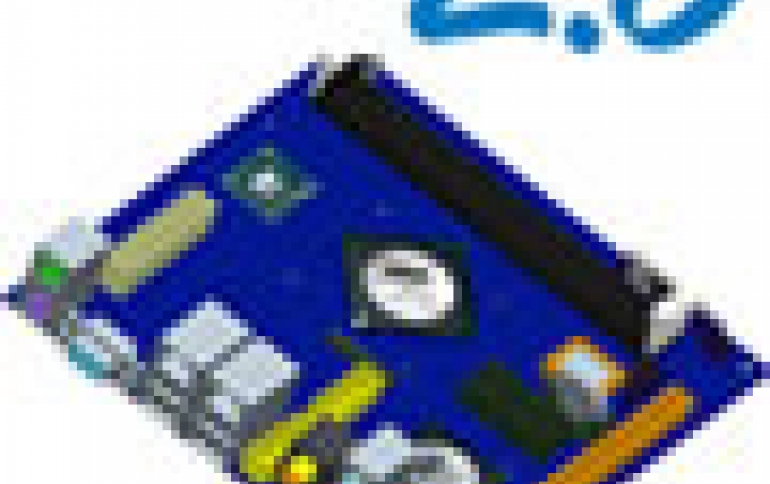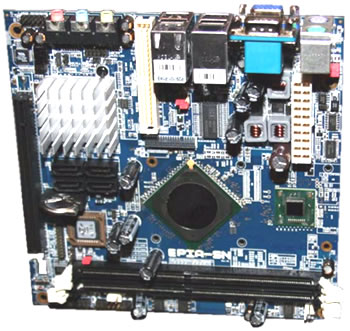
VIA, NVIDIA Promote Mini-ITX 2.0 Standard
VIA Technologies officially announced on Thursday its new VIA Nano processor (Isaiah) and a new standard for small form factor motherboards, Mini-ITX 2.0.
In an event held in Computex, Taipei, VIA's representatives were eager to inform the audience that the event was not about any possible merger between VIA and Nvidia, or any announcement of an upcoming UMA chipset for VIA processors. VIA talked about the cooperation with Nvidia on the development promotion of the new Mini-ITX 2.0 small-factor motherboards and of course, the Nano processors.
"VIA has pioneered small form factor PCs, in contrast to competing closed designs, VIA's new solution allows customers to play today's latest PC games and experience new video and photo applications available with NVIDIA's DX10 GPUs," stated Drew Henry, general manager, NVIDIA MCP business.
However, sources have revealed that Nvidia's first VIA CPU-based chipsets will be launched in the first quarter of 2009.
VIA nano processor family
The new VIA Nano processor family based on the VIA Isaiah Architecture, Via's low-power processor that will compete with Intel's Atom processor in the mainstream PC segment.
Nano is based on the x86 architecture, meaning it can run the same software as chips from Intel and AMD. The VIA Nano processor family offers as much as four times the performance within the same power range, the company claims. Pin compatibility with VIA C7 processors are also ensuring a smoother transition for OEMs and motherboard vendors.
The first 64-bit processors in VIA's x86 platform portfolio, VIA Nano processors have been specifically designed to revitalize traditional desktop and notebook PC markets, delivering optimized performance for demanding applications, including Blu-ray Disc HD video playback and the latest PC games, such as Crysis.
The VIA Nano processor family is built upon Fujitsu's 65 nanometer process technology for enhanced power efficiency, and comes in a compact 21mm x 21mm nanoBGA2 package. Its's idle power is just 100mW (0.1W). One of the principal differences between Nano and intel's Atom chip is that the latter uses a more simple "in-order execution" design compared to Nano's superscalar, out-of-order design. Because of this more sophisticated design, Nano may deliver better performance than Atom in some cases, VIA claims.
The five Nano processors are split into two types, the Nano L series and the Nano U series.
The L, or Low Voltage, series comprises two chips, the 1.6GHz L2100 and 1.8Ghz L2200. The chips have a maximum TDP (thermal design power) of 25.5 watts and 17 watts, respectively. This line will eventually be expanded with the addition of a 2GHz chip, but the company hasn't set a date for its release.
VIA Mini-ITX 2.0
VIA announced a new standard for Mini-ITX boards for small form factor desktop PCs.
At the core of Mini-ITX 2.0 is a high performance yet power efficient x86 processor, such as the VIA Nano processor, to provide all the horsepower necessary for running the latest applications and operating systems. DirectX 10 graphics and Blu-ray Disc playback are supported, as well as a 16-lane PCI Express slot, enabling the integration of a high performance graphics add-in card.
 "With the Mini-ITX, VIA set the de facto standard for small form factor x86 platform integration, triggering industry-wide innovation in mini PC systems," said Timothy Chen, Special Assistant to the President, VIA Technologies, Inc. "Through the introduction of Mini-ITX 2.0, we are defining the mini PC platform of the future, paving the way for the emergence of a new generation of high performance systems that deliver an optimized experience in today's increasingly media rich environment."
"With the Mini-ITX, VIA set the de facto standard for small form factor x86 platform integration, triggering industry-wide innovation in mini PC systems," said Timothy Chen, Special Assistant to the President, VIA Technologies, Inc. "Through the introduction of Mini-ITX 2.0, we are defining the mini PC platform of the future, paving the way for the emergence of a new generation of high performance systems that deliver an optimized experience in today's increasingly media rich environment."
Other specifications defined in the standard include: a minimum of four USB 2.0 ports, Gigabit LAN, and at least two SATA and one IDE ports. Motherboards will still measure 170?170mm as defined by the original Mini-ITX spec.
Compared to Intel's requirements for Atom platform motherboards, which some consider more a list of what makers must not include on their boards, Mini-ITX 2.0 has the advantage in allowing more than one DIMM slot and PCI Express expansion, rather than just PCI.
Key features of the Mini-ITX 2.0 Standard include the following:
- Processor: High-performance, power efficient x86 processor, such as the VIA Nano processor
- Memory: Support for minimum 2GB DDR2 SDRAM
- Graphics: DirectX 9.0 integrated (IGP); DirectX 10 through an add-in card
- Display: 1 VGA port for LCD display; 1 HDMI port on add-in card
- HD Audio: 3 Audio jacks for up to 6-channel surround sound
- Broadband Connectivity: 1 Gigabit LAN port
- Storage: 2 Serial ATA II slots + 1 IDE (PATA) slot
- Peripheral Connectivity: Minimum 4 USB2.0 ports
- Expansion: 1 PCI Express 16-lane slot
- Size: 17cm x 17cm
- O/S Support: Microsoft Windows Vista; Microsoft Windows Vista Premium (through an add-in graphics card); Microsoft Windows XP, and major Linux distributions such as Ubuntu, Suse Linux and gOS
"VIA has pioneered small form factor PCs, in contrast to competing closed designs, VIA's new solution allows customers to play today's latest PC games and experience new video and photo applications available with NVIDIA's DX10 GPUs," stated Drew Henry, general manager, NVIDIA MCP business.
However, sources have revealed that Nvidia's first VIA CPU-based chipsets will be launched in the first quarter of 2009.
VIA nano processor family
The new VIA Nano processor family based on the VIA Isaiah Architecture, Via's low-power processor that will compete with Intel's Atom processor in the mainstream PC segment.
Nano is based on the x86 architecture, meaning it can run the same software as chips from Intel and AMD. The VIA Nano processor family offers as much as four times the performance within the same power range, the company claims. Pin compatibility with VIA C7 processors are also ensuring a smoother transition for OEMs and motherboard vendors.
The first 64-bit processors in VIA's x86 platform portfolio, VIA Nano processors have been specifically designed to revitalize traditional desktop and notebook PC markets, delivering optimized performance for demanding applications, including Blu-ray Disc HD video playback and the latest PC games, such as Crysis.
The VIA Nano processor family is built upon Fujitsu's 65 nanometer process technology for enhanced power efficiency, and comes in a compact 21mm x 21mm nanoBGA2 package. Its's idle power is just 100mW (0.1W). One of the principal differences between Nano and intel's Atom chip is that the latter uses a more simple "in-order execution" design compared to Nano's superscalar, out-of-order design. Because of this more sophisticated design, Nano may deliver better performance than Atom in some cases, VIA claims.
The five Nano processors are split into two types, the Nano L series and the Nano U series.
The L, or Low Voltage, series comprises two chips, the 1.6GHz L2100 and 1.8Ghz L2200. The chips have a maximum TDP (thermal design power) of 25.5 watts and 17 watts, respectively. This line will eventually be expanded with the addition of a 2GHz chip, but the company hasn't set a date for its release.
VIA Mini-ITX 2.0
VIA announced a new standard for Mini-ITX boards for small form factor desktop PCs.
At the core of Mini-ITX 2.0 is a high performance yet power efficient x86 processor, such as the VIA Nano processor, to provide all the horsepower necessary for running the latest applications and operating systems. DirectX 10 graphics and Blu-ray Disc playback are supported, as well as a 16-lane PCI Express slot, enabling the integration of a high performance graphics add-in card.
 "With the Mini-ITX, VIA set the de facto standard for small form factor x86 platform integration, triggering industry-wide innovation in mini PC systems," said Timothy Chen, Special Assistant to the President, VIA Technologies, Inc. "Through the introduction of Mini-ITX 2.0, we are defining the mini PC platform of the future, paving the way for the emergence of a new generation of high performance systems that deliver an optimized experience in today's increasingly media rich environment."
"With the Mini-ITX, VIA set the de facto standard for small form factor x86 platform integration, triggering industry-wide innovation in mini PC systems," said Timothy Chen, Special Assistant to the President, VIA Technologies, Inc. "Through the introduction of Mini-ITX 2.0, we are defining the mini PC platform of the future, paving the way for the emergence of a new generation of high performance systems that deliver an optimized experience in today's increasingly media rich environment."Other specifications defined in the standard include: a minimum of four USB 2.0 ports, Gigabit LAN, and at least two SATA and one IDE ports. Motherboards will still measure 170?170mm as defined by the original Mini-ITX spec.
Compared to Intel's requirements for Atom platform motherboards, which some consider more a list of what makers must not include on their boards, Mini-ITX 2.0 has the advantage in allowing more than one DIMM slot and PCI Express expansion, rather than just PCI.
Key features of the Mini-ITX 2.0 Standard include the following:
- Processor: High-performance, power efficient x86 processor, such as the VIA Nano processor
- Memory: Support for minimum 2GB DDR2 SDRAM
- Graphics: DirectX 9.0 integrated (IGP); DirectX 10 through an add-in card
- Display: 1 VGA port for LCD display; 1 HDMI port on add-in card
- HD Audio: 3 Audio jacks for up to 6-channel surround sound
- Broadband Connectivity: 1 Gigabit LAN port
- Storage: 2 Serial ATA II slots + 1 IDE (PATA) slot
- Peripheral Connectivity: Minimum 4 USB2.0 ports
- Expansion: 1 PCI Express 16-lane slot
- Size: 17cm x 17cm
- O/S Support: Microsoft Windows Vista; Microsoft Windows Vista Premium (through an add-in graphics card); Microsoft Windows XP, and major Linux distributions such as Ubuntu, Suse Linux and gOS
















